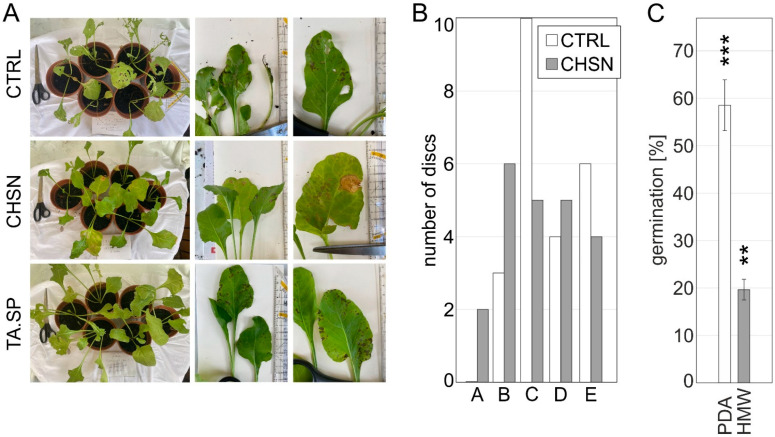Figure 6.
B. vulgaris young plants primed with HMW chitosan or T. atroviride spores show systemic resistance toward CLS from C. beticola. (A) B. vulgaris in a greenhouse experiment was infected with 104 spores mL−1 from C. beticola seven days after the third foliar treatment with either 1 mg mL−1 of high-molecular-weight chitosan solution pH 4.5 (HMW), T. atroviride 104 spores (TA.SP) or deionized water pH 4.5 (control). Photographs of the plants and leaves were taken 14 days post-infection to estimate CLS severity and frass (see Table 2). (B) Leaf disc assay to estimate disease severity of CLS disease. Leaves from B. vulgaris plants were sprayed 24 h before assay start with 1 mg mL−1 of HMW chitosan (CHSN) or deionized, acidified water pH 4.5 (control). 10 mm leaf discs were cut from these leaves, placed on water agar, and sprayed with 104 spores mL−1 C. beticola. After 14 days, the development of CLS was recorded and categorized per leaf disc (n = 22 discs for CHSN and 23 discs for the control). The number of discs falling into each category is given. Category A = 0 CLS, B ≤ 5 CLS, C = 6–10 CLS, D = 11–20 CLS, and E > 20 CLS. (C) Germination efficiency of C. beticola compared to total amount of spores spread on PDA or PDA supplemented with 1 mg ml−1 of HMW chitosan (HMW). ** and *** indicate p < 0.01 and p < 0.001 (Poisson), respectively.

